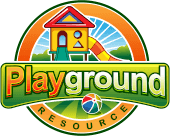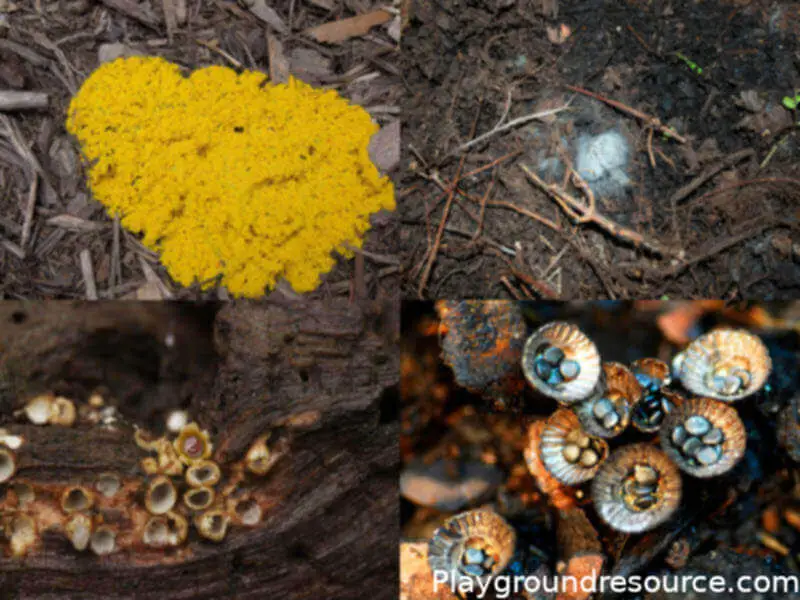
Today I’ll share the most common types molds that you can encounter growing on your playground mulch and in your playground area, if they are dangerous, and how to dispose of them safely and properly without causing the mold to spread.
I’ll also share the most effective methods to prevent the mold from coming back, other preventative measures, and how to get rid of the mold for good.
Table of Contents
What Causes Mold to Form on Your Playground Surface?
The main reasons that cause mold to grow on your playground mulch are:
- Hot and humid climate. This obviously can’t be helped, but solving the next two causes are key to eliminating and preventing these molds from coming back or ever appearing
- Shady area with little exposure to sunlight. If your playground area is in full shade, and you’re having mold problems then you may want to consider moving your playground area into a pot that at least gets partial sunlight or sunlight for a few hours a day. If this is not possible, you need to ensure proper drainage in your playground area.
- Improper drainage. This is the main cause of mold forming on your playground mulch and in your playground area. When your mulch stays moist, it is a breeding ground for bacteria and fungus. If you are having major drainage problems that there is no solution for, then you may want to cut back on the depth of your playground mulch to help keep it dry. Periodically rake and fluff the mulch to help in drying. This along with the “treatments” and preventive measures, which I will discuss later in the article will help get rid of the mold and keep it out
Most Common Molds You’ll Encounter on Playground Mulch
Now let’s discuss the different types of mold you can encounter on your playground mulch and if they are dangerous. I’ll tell you how to properly collect and dispose of the mold, then later we’ll go over treatment methods to prevent the mold from coming back along with preventive measures that you can take.
Slime Mold
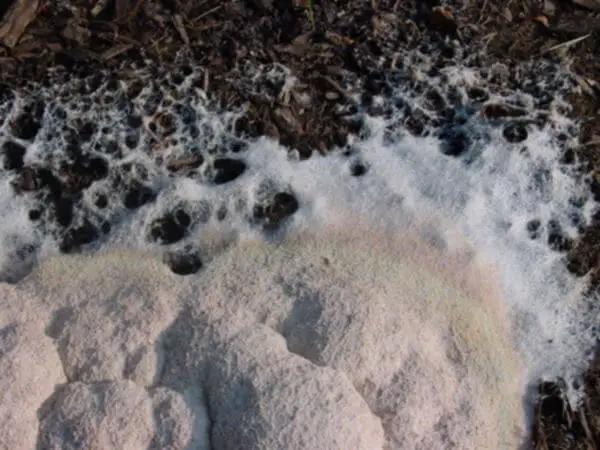
Slime mold is a brainless, single-cell organism that moves slowly around feeding on bacteria and organic matter. Creepy and fascinating! Classified under the kingdom Protista, this organism is not classified as a plant, animal or fungus.
- Identification
A small or large blog that can come in almost any color of the rainbow from green to pink. Slime mold will eventually turn a dark brownish color before drying out to a white powdery substance.
Because of the variety of colors and forms, this mold can easily trick someone into thinking they have several different types of molds growing.
- Is Slime Mold Harmful?
Slime mold is non-toxic and not harmful unless eaten. It’s best to remove this mold because children are curious and slime mold can be a mess if it gets on clothing or shoes.
- How to get rid of it
Scoop up the mold and mulch under and around it (1-foot parameter) with a shovel, being careful not to spread it around. Put in a plastic garbage bag and throw away to prevent the spores from spreading. If the mold has already dried to a white powdery substance be extra careful because these spores are very easy to spread. But don’t worry, later in the article I’ll tell you an easy way to treat your whole playground surface to keep this mold out for good.
Artillery/Shotgun Mold
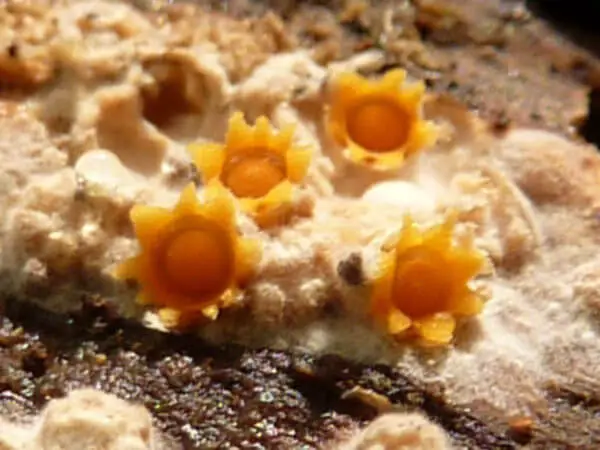
Not a toxic mold, but can still cause unsightly damage to your playground equipment anything else that’s around.
This mold can be found in any wood mulch but appears most commonly in bark and hardwood mulches. Artillery mold is often found during cooler weather but can also make an appearance during the summertime.
A tell-tale sign of artillery mold is the black spots it leaves behind, most noticeable on lighter colored surfaces and playground equipment. These black spots will leave a stain that can be very hard to remove.
- Identification
Small (1/10 of an inch) “cups” that can be cream to orangish-brown in color. You may notice the black spots this mold leaves behind before you notice the little “cups’. These black spots can become permanent.
- Is artillery mold harmful?
Artillery mold is non-toxic but can leave unsightly black spots which stain.
- How to get rid of it
Scoop up the mold with a shovel being very careful to remove any equipment that is close by (and anything you don’t want to be stained with black spots) because as the name suggests, this fungus will shoot black spores up to 20 feet which will stick to any surface. Place in a plastic garbage bag for disposal.
If you already have black spots on playground equipment because of this mold, then you will have to pressure wash the equipment, which will still not remove all of the spots.
After a pressure washing, fine-grit sandpaper will do a good job of removing any remaining black spots.
Bird Nest Mold
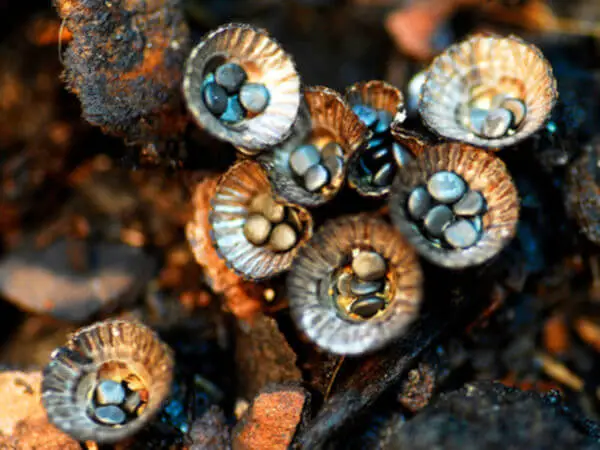
This mold looks just like a miniature bird’s nests with eggs in them. You will most likely see this mold during the fall time or during cooler weather. The “nests” are usually only about 1/4 of an inch in diameter. The “eggs” are actually the spores that spread the mold.
- Identification
Exactly as their name states, this mold looks exactly like very small bird’s nests (1/4 of an inch in diameter, sometimes larger) with eggs in them. Easily identifiable.
- Is bird nest mold harmful?
Bird nest mold is non-toxic, but no studies have been done to determine if this mold will cause damage if eaten.
- How to get rid of it
Scoop up the mold with a shovel, being careful not break the “eggs” (spores) and put in a plastic garbage bag for disposal.
How to Treat Your Playground Area to Keep the Mold From Coming Back
If you have mold that only appears once or so a year, then you’re in good shape, this is quite common. For these rare instances, you can simply scoop the mold out, along with the mulch underneath and around it.
If you want to be sure the mold will not return or if you are having serious mold problems use these methods listed below. These methods are easy to do yourself and the costs are very inexpensive.
Method One
Heavy-duty laundry detergent and Water. Mix 1 part heavy-duty laundry detergent to 3 parts water in a pump sprayer.
After removing the mold (optional but suggested), or for preventative treatments soak your playground mulch in this mixture to kill the bacteria that the mold is feeding on, thus preventing the mold from coming back or forming in the first place.
You can get an 18-pound bucket of heavy-duty laundry detergent (above picture) that works great for a very affordable price and a 2-gallon pump sprayer.
Method Two
Distilled White Vinegar and Water. Mix 1 part white vinegar with 1 part water in a pump sprayer.
Vinegar has been shown to directly kill 82% of fungus species, including the fungus that is most commonly found growing on and in the mulch. This is a safe, effective and natural way to kill the mold. If you have a lot of mold and fungus growing everywhere in your playground area, this is a good method to use.
You can get white vinegar for cheap from your local grocery store.
Method Three
Baking Soda. You can sprinkle baking soda directly onto slime mold to kill it. Baking soda does not directly kill fungus, but remember, slime mold is not a fungus.
While baking soda can create a “hostile” living conditions for fungus, I only recommend this method for slime mold, trying to use baking soda to kill other molds on your playground mulch will not be very effective. Baking soda has many other uses and is quite inexpensive, you can get an affordable 15-pound bag.
How to Keep Your Playground Area Free of Mold for Good
The two main things to ensure mold doesn’t stand a chance in your playground mulch is proper drainage and sunshine.
Wet wood in a shaded area is a breeding ground for fungus.
Periodically “fluff” and rake your playground mulch. This helps in the drying process and can keep any mold from forming. Mold needs moisture to form.
If you just can’t get good drainage and/or any access to sunlight in your playground area, then the first two treatments I mentioned above, when applied bi-monthly (If you have a big mold problem) or when the first signs of mold show will keep the mold out.
If your problem is severe, and you are tired of battling the mold, then there are alternatives to wood playground mulch.
Let’s explore those alternatives.
Alternatives to Wood Playground Mulch
- Rubber Mulch
Rubber mulch can be a good alternative to wood mulch, especially if you have serious mold and/or drainage problems.
Rubber mulch doesn’t retain water like wood mulches do, therefore won’t be a host to mold. It’s more expensive but lasts much, much longer. For more detailed information on Rubber Mulch please read my article titled “What is Rubber Playground Mulch – Rubber Mulch Vs Wood Mulch“.
- Playground Sand or Pea Gravel
These materials have been used in playgrounds for a long time and are still a great option.
If you’re having drainage issues, it’s best to go with pea gravel. Both are these materials are very inexpensive and will last a very long time. If you want to know more about Playground Sand and Pea Gravel please read my article titled, “Backyard Playground Ground Cover – 5 Best Materials to DIY“
Final Thoughts and Considerations
Mold can be very unsightly, and if you can’t identify it – scary. You don’t want your children around potentially harmful mold and other fungi.
Remember that slime mold is the most common mold found on wood mulch, and can take different shapes and many different colors.
Still, you don’t want a big glob of this stuff in your playground area. Children will poke at it and play with it out of curiosity.
Each of the methods I listed above will definitely remove the molds that have formed in and on your playground mulch.
Remember, you may need to lessen the depth, especially if the mulch and/or wood chips are several years old. Decaying and rotting wood holds more moisture and is a strong breeding ground for mold and bacteria.
In that case, it would be a good idea to rake back the top half and remove the bottom half, replacing it with fresh mulch. Or just replace all of it altogether.
Wood as a playground ground cover makes a great natural surface for your kids to play on, and there are several different types of wood mulch you can go with, some lasting longer than others. For more information on other wood mulches you can use, check out my article titled “Wood Mulch for Playgrounds – Your Ultimate Guide“.
Whatever you decide, I hope this article has helped you in some way, enjoy and have fun!

